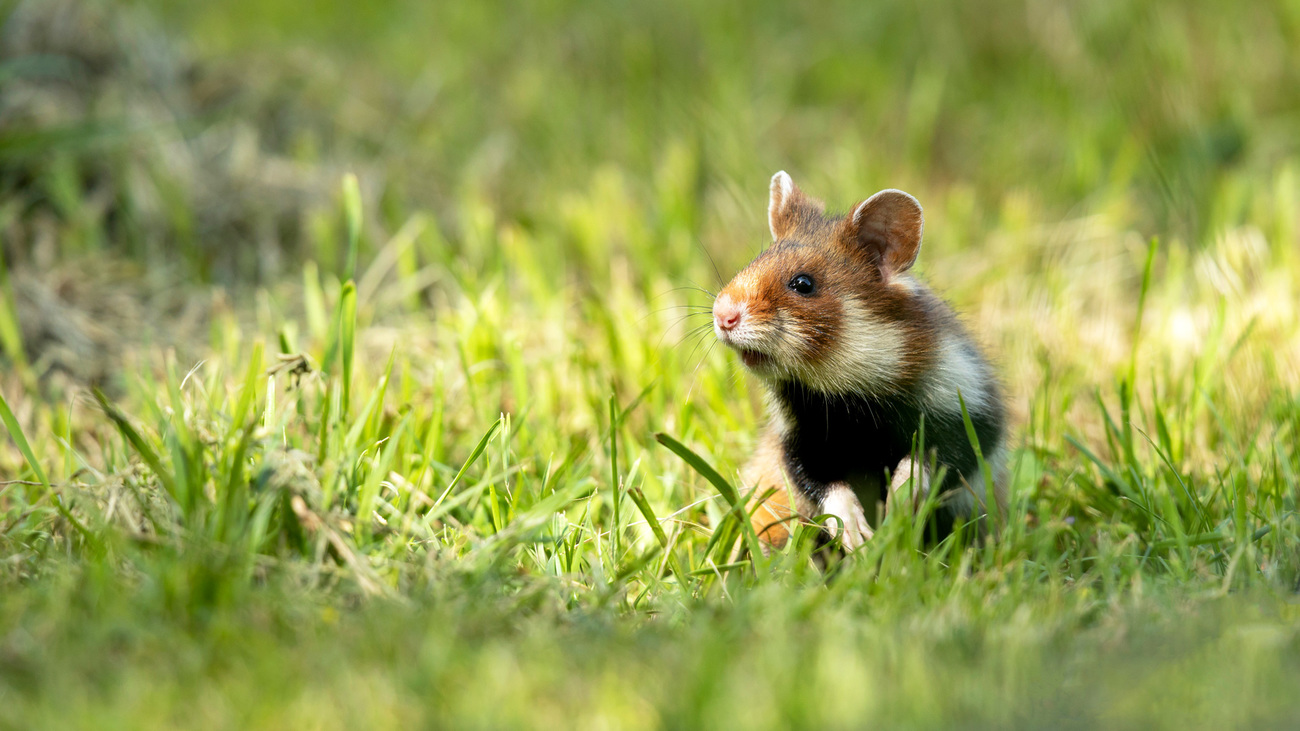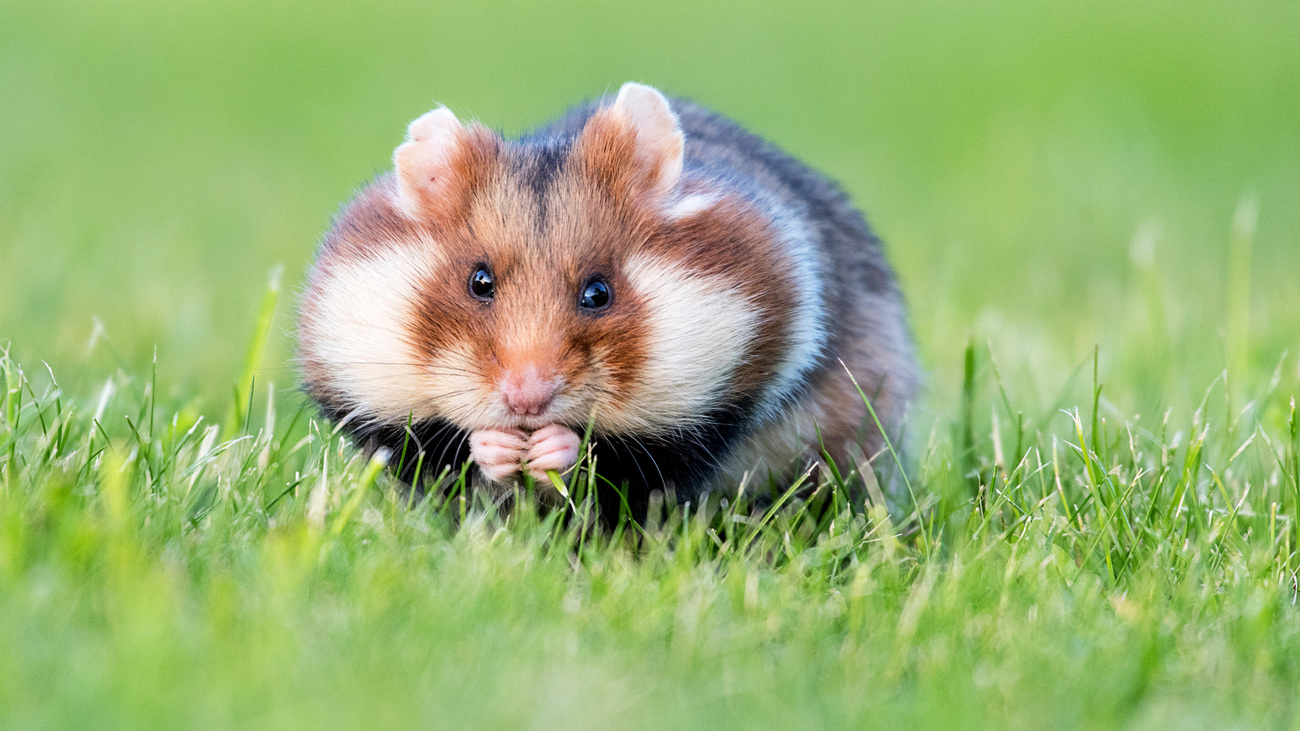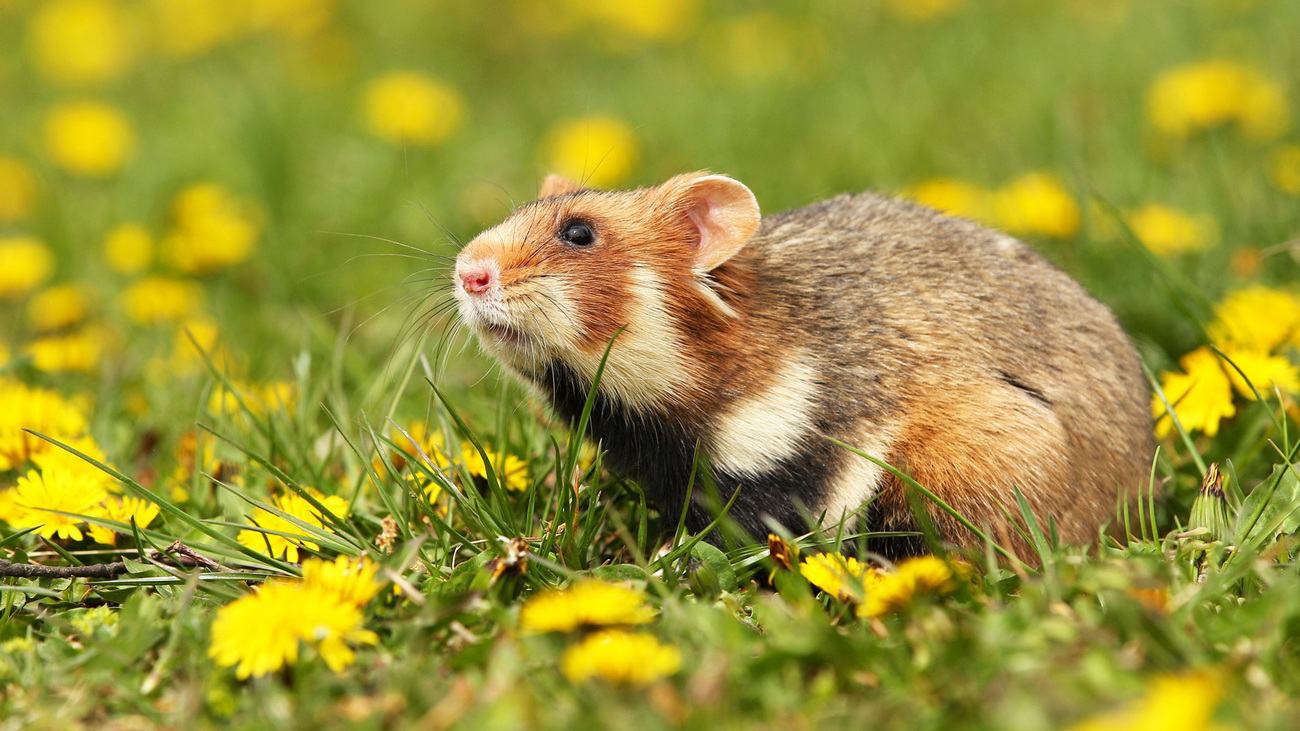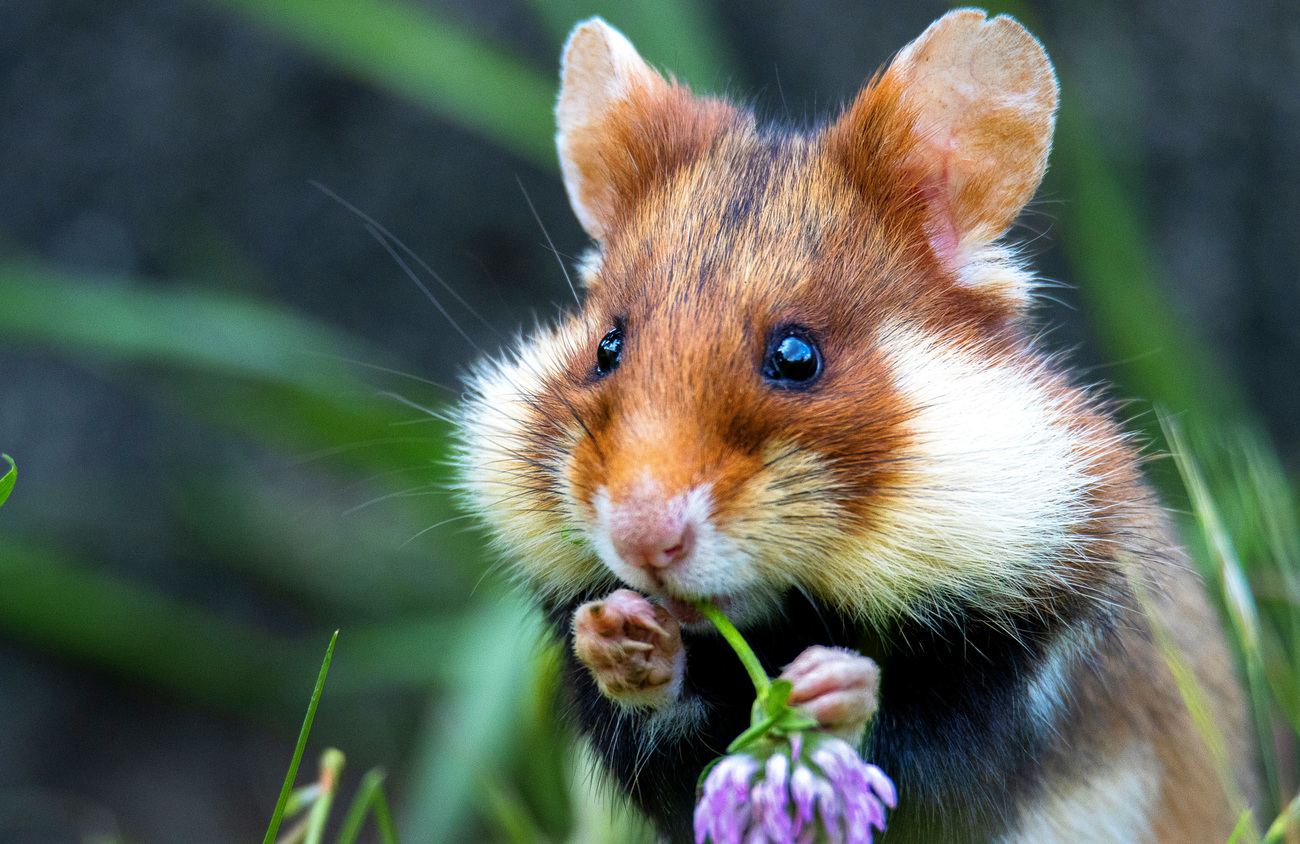Wild hamsters
What is a wild hamster?
When someone says ‘hamster’, chances are that your first thought would be of the cute little critters that are often kept as pets. However, of the 20 hamster species in existence, only five of them are domesticated.
Fifteen species of wild hamsters live across Europe and western Asia. They’re small rodents with stocky bodies, recognised by their short tails and small, fluffy ears. Typically, wild hamsters have reddish-brown or grey fur. Their underbody fur is often a different colour, ranging from black to grey or white.
Even the largest species of hamster are still very small animals, measuring no more than 34 centimetres (or 14 inches) long. Dwarf desert hamsters are the smallest species, with a body that is only 5 to 10 centimetres (about two to four inches) long.
As nocturnal animals, wild hamsters are mostly active at night, though they have been observed to be extra active in the early morning and late evening. They’re generally solitary creatures, preferring to live and eat on their own. They are also highly territorial.
Hamsters make their dens underground and have evolved to become excellent diggers. As such, wild hamsters typically inhabit grasslands, farmlands, and meadows with suitable burrowing conditions. They avoid rocky, mountainous regions where the ground is too hard. They construct elaborate burrows with multiple entrances and rooms, which they use for sleeping, nesting, and food storage. These burrows also provide excellent protection from predators and harsh weather conditions.
Wild hamsters are omnivores, consuming mostly grains, seeds, roots, and insects. Like many other animals, their diet can vary based on seasonal availability. Hamsters forage for food, store it in their large cheek pouches, and bring it back to their burrows to consume later.
Though they’re typically unsocial creatures, they do engage in socialisation during the mating season. Hamsters have a remarkably short gestation period, lasting around 13 to 22 days. A litter usually consists of 4 to 12 pups, and the mother is solely responsible for caring for and raising the young. Female hamsters can become pregnant again shortly after giving birth, meaning they breed at a very fast pace. Breeding season lasts from April to October, and a female hamster usually gives birth to two to five litters per season.
Wild hamsters play important roles in their ecosystems by assisting with seed dispersal. As they forage for food and store it in their burrows, they contribute to the distribution of plants, which helps with vegetation growth and biodiversity. They also serve as prey for various predators.
Unfortunately, some species of wild hamsters—particularly the European hamster—face numerous threats that threaten the survival of their species. These include the expansion of agriculture, which has destroyed and fragmented their natural habitat.
What is a wild hamster’s scientific name?
The scientific name for the common hamster is Cricetus cricetus. This species has a widespread range across Europe and Russia.
All hamsters belong to the family Cricetidae and the subfamily Cricetinae. There are eight genera within this subfamily:
- Mesocricetus
- Phodopus
- Cricetus
- Cricetulus
- Nothocricetulus
- Allocricetulus
- Cansumys
- Tscherskia
Here are the common and scientific names of 14 other wild hamster species:
- Golden hamster or Syrian hamster (Mesocricetus auratus)
- Grey dwarf hamster (Nothocricetulus migratorius)
- Romanian hamster (Mesocricetus newtoni)
- Desert hamster (Mesocricetus newtoni)
- Brandt’s hamster (Mesocricetus brandti)
- Campbell’s hamster (Phodopus campbelli)
- Gansu hamster (Cansumys canus)
- Mongolian hamster (Allocricetulus curtatus)
- Eversmann’s hamster (Allocricetulus eversmanni)
- Striped dwarf hamster (Cricetulus barabensis)
- Tibetan dwarf hamster (Cricetulus tibetanus)
- Sokolov’s dwarf hamster (Cricetulus sokolovi)
- Lama dwarf hamster (Cricetulus lama)
- Long-tailed dwarf hamster (Cricetulus longicaudatus)
Are wild hamsters endangered?
The common hamster (Cricetus cricetus) has been listed as critically endangered on the IUCN Red List since 2019. Though they were previously categorised as least concern, their numbers have dwindled significantly over the last decade. In fact, wild hamsters experienced a 50% reduction in their population each year, which is equivalent to a reduction of at least 99% over the next 10 years.
These hamster populations are significantly declining, and their conservation should be a top priority. If this trend continues, the common hamster will become extinct in less than 30 years.
The golden hamster (Mesocricetus auratus), also known as the Syrian hamster, is listed as endangered.
Where do hamsters live in the wild?
Wild hamsters are native to various regions of Europe and parts of Asian Russia. Their habitat stretches from Western European countries through Central and Eastern Europe into Western Asia.
The small rodents usually live in grasslands, meadows, farmland, steppes, and fields. They can also be spotted in gardens and hedgerows.
Threats
Wild hamsters face several threats that impact their habitats and survival, all of which have contributed to the devastating decrease in their numbers over the last few decades. The key threats to wild hamsters include agriculture expansion, habitat loss and fragmentation, human persecution, and light pollution.

Agriculture expansion
The wild hamster’s natural habitat is continuously being converted into agricultural fields, destroying their burrows and the foraging grounds where they find food. This has a devastating impact on the overall health and survival rates of wild hamsters. In Alsace, France, for example, the body mass of wild hamsters emerging from hibernation has decreased by 20% in the last 70 years, signifying a lack of quality food sources.
Because of agricultural expansion, wild hamsters are increasingly exposed to pesticides used in farming practices. They are more likely to consume contaminated food sources, leading to poisoning and population decline.
Habitat loss and fragmentation
Habitat loss and fragmentation directly result from urbanisation, the building of infrastructure, and other human activities. These processes disrupt the natural landscapes where wild hamsters live, drastically reducing the availability of suitable burrowing sites.
Though hamsters are not necessarily social creatures, population fragmentation can be a death sentence. It leads to island populations, in which small communities of wild hamsters are cut off from each other. This increases the likelihood of inbreeding, resulting in a lack of genetic diversity—a problem which can escalate quickly due to the short gestation period and lifespan of wild hamsters.
Human persecution
Agricultural practices have expanded over Central and Western Europe in the last half-century, encroaching on the natural habitat of wild hamsters.
For many years, wild hamsters were captured and killed by farmers who feared they would destroy their crops and land. They were also targeted for the fur trade.
While they’re no longer hunted as frequently today, with no signs of agricultural expansion slowing down any time soon, human activities pose a real threat to the survival of wild hamsters.
Light pollution
Artificial light can wreak havoc on the natural behaviours of wild animals, and wild hamsters are no exception. Excess artificial light in their natural habitats—which should otherwise be dark—affects their foraging, reproduction, and sleep patterns. As nocturnal creatures, light pollution also disrupts their circadian rhythms, impacting their overall health and survival.
One study found that exposure to light for just two nights during winter shifted the onset of wild hamsters’ reproductive phase by up to four weeks.
FAQs
Do hamsters live in the wild?
Though hamsters are often thought of only as domesticated pets, there are around 15 species of hamsters that live in the wild, from the tiny dwarf hamster that can fit in your palm to the common European hamster, which is the length of your forearm.
Wild hamsters live across Europe and some parts of Asia.
What does a wild hamster look like?
Wild hamsters share a lot of characteristics with domesticated hamsters and other rodents. They have stocky bodies, stumpy legs, short tails, and small, rounded ears. They’re covered in fur, which varies in colour from reddish-brown to grey. The underbody of a wild hamster is typically white, grey, or black. Some also have markings on their faces and bodies.
The biggest wild hamsters are up to 34 centimetres long (14 inches) with a tail of around 6 centimetres (2.5 inches) and weigh around 400 grams (14 ounces). Dwarf hamsters are only 5 to 10 centimetres (two to four inches) long.

How long do wild hamsters live?
In the wild, hamsters have a life expectancy of just two to three years.
How do wild hamsters protect themselves?
As fiercely territorial animals, hamsters not only have to protect themselves from predators but from other hamsters too.
They rely on body language to convey their emotions, whether that be fear, excitement, curiosity, or anger. When surprised or caught off guard by a predator—like a fox or bird of prey—they jump up on their hind legs to make themselves appear larger.
This display of ferocity, along with the markings on a wild hamster’s underbelly, is usually enough to scare off their attacker.
How do hamsters survive in the wild?
Hamsters are excellent diggers and create burrows consisting of multiple tunnels and chambers underground. Not only does this make an ideal space for nesting and food storage, but it also offers protection from predators and harsh winter weather conditions.
These burrows can be up to two metres deep and each is inhabited by just one hamster (except when females are raising their young). They’re incredibly elaborate, made up of two types of tunnels: a vertical ‘trap pipe’ used for making quick escapes and a sloping corridor used to funnel dirt out of the burrow.
Wild hamsters spend most of the day inside their burrows and come out at night to forage.
What do hamsters eat in the wild?
Hamsters are foragers. Their diet is primarily made up of fruits, seeds, grasses, and herbs, though they occasionally eat insects and small invertebrates.
Because the food supply is never constant, hamsters forage and store food while it’s readily available. They stash it in their cheek pouches and then return to their burrows, where it’s safely kept until the food supply outside runs out.
On average, wild hamsters keep a horde of about two to three kilograms of food stashed in their burrows, though they have been known to keep up to 65 kilograms.
Are hamsters nocturnal?
All hamsters are nocturnal, which means they’re most active at night. They have very poor eyesight, so they rely on smell, touch, and sound to guide themselves around their habitats, searching for food and avoiding predators.
Are hamsters rodents?
Yes, hamsters are rodents; they belong to the subfamily Cricetinae within the order Rodentia.
Rodents are a diverse group of mammals characterised by continuously growing incisor teeth, a characteristic that hamsters share with other rodents like mice, rats, squirrels, and beavers.
Can I release my hamster into the wild?
You should never release a pet into the wild. Your pet hamster is used to life in an enclosure and has not learned to defend itself or forage for food.
Why are wild hamsters important?
Wild hamsters are important for ecosystem balance as they contribute to seed dispersal, aiding vegetation growth and biodiversity. Additionally, they serve as prey for various predators, playing a key part in the food chain.
Our work
Due to the exceedingly small number of hamsters remaining in the wild and the diminishing gene pool, conservationists have set up science-based breeding programmes to help increase hamster populations. One of these programmes operates at the Breeding and Reintroduction Centre for Protected Species located at Kyiv Zoo in Ukraine.
To support this programme, IFAW has provided urgent financial support to the Ukrainian Nature Conservation Group (UNCG) between April 2023 and May 2024 to cover expenses related to feed, veterinary care, supplies, and lightweight cages for wild hamsters.
IFAW’s emergency assistance has also facilitated the launch of a new initiative responding to incidents of human-wildlife conflict. Historically, homeowners who found hamsters in their gardens would kill them as pests. This new programme aims to capture these wild hamsters and reintroduce them in the wild—far from humans—or incorporate them into the existing breeding programme.
Those entering the programme are introduced to other hamsters and encouraged to mate. Once offspring are born, the entire family is released back into their natural habitat.

How can you help?
Wild hamsters are constantly under threat and, without our help, they could go extinct before 2050.
If you live in an area with wild hamsters, remember that they are important animals—not garden pests. Contact the appropriate authorities in your area to help return them to the wild instead of approaching them yourself.
Supporting conservation programmes to help wild hamsters breed and return to the wild can help save them from extinction.
